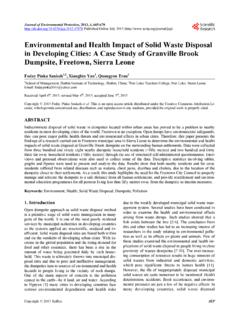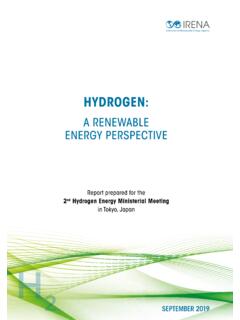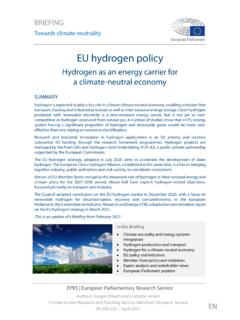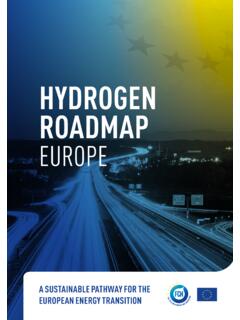Transcription of Hydrogen Production Technologies Overview
1 Journal of Power and Energy Engineering, 2019, 7, 107-154 ISSN Online: 2327-5901 ISSN Print: 2327-588X Hydrogen Production Technologies Overview Mostafa El-Shafie*, Shinji Kambara, Yukio Hayakawa Environmental and Renewable Energy Systems Division, Gifu University, Gifu City, Japan Abstract Hydrogen energy became the most significant energy as the current demand gradually starts to increase. Hydrogen energy is an important key solution to tackle the global temperature rise. The key important factor of Hydrogen pro-duction is the Hydrogen economy. Hydrogen Production Technologies are commercially available, while some of these Technologies are still under devel-opment.
2 This paper reviews the Hydrogen Production Technologies from both fossil and non-fossil fuels such as (steam reforming, partial oxidation, auto thermal, pyrolysis, and plasma technology). Additionally, water electrolysis technology was reviewed. Water electrolysis can be combined with the renewa-ble energy to get eco-friendly technology. Currently, the maximum Hydrogen fuel productions were registered from the steam reforming, gasification, and partial oxidation Technologies using fossil fuels. These Technologies have dif-ferent challenges such as the total energy consumption and carbon emissions to the environment are still too high.
3 A novel non-fossil fuel method [ammonia NH3] for Hydrogen Production using plasma technology was reviewed. Ammo-nia decomposition using plasma technology without and with a catalyst to produce pure Hydrogen was considered as compared case studies. It was showed that the efficiency of ammonia decomposition using the catalyst was higher than ammonia decomposition without the catalyst. The maximum hy-drogen energy efficiency obtained from the developed ammonia decomposition system was with a Hydrogen purity of The development of am-monia decomposition processes is continues for Hydrogen Production , and it will likely become commercial and be used as a pure Hydrogen energy source.
4 Keywords Hydrogen Technology, Hydrogen Production , Steam Reforming, Plasma, Ammonia Decomposition 1. Introduction Energy is the most important needs for the human life and development of the How to cite this paper: El-Shafie, M., Kambara, S. and Hayakawa, Y. (2019) Hy-drogen Production Technologies Overview . Journal of Power and Energy Engineering, 7, 107-154. Received: December 5, 2018 Accepted: January 25, 2019 Published: January 28, 2019 Copyright 2019 by author(s) and Scientific Research Publishing Inc. This work is licensed under the Creative Commons Attribution International License (CC BY ).
5 Open Access DOI: Jan. 28, 2019 107 Journal of Power and Energy Engineering M. El-Shafie et al. worldwide. So, energy is the world key consideration in all discussions and meetings of the sustainable energy development. The renewable energy sources, such as solar energy, wind energy, waves, and tides energy are considered eco-friendly. It is expected that the Hydrogen fuel and its demand will rise ra-pidly over the next few decades [1] [2]. The Hydrogen energy utilization, as an energy source and storage methods, has been reviewed [3]. The recycling of the waste materials to useful energy sources through waste-to-energy Technologies such as Hydrogen , biogas, etc.
6 , has been reviewed [4]. The importance of hydro-gen fuel is known as alternative clean energy and to overcome the fossil fuels depletion due to the high extension usage. In addition, fossil fuels have a bad ef-fect on the environment due to combustion product gases such as carbon oxides, nitrogen, sulfur, etc. which have the main responsibilities of the global warming [5]. Hydrogen fuel is considered the alternative clean energy fuel and it can be produced from eco-friendly sources. In the current state, it is investigated that too little quantity of Hydrogen is produced from the renewable energy resources through water electrolysis and the highest quantity is still generated from fossil fuels [6] [7].
7 Due to the Hydrogen fuel advantages and versatility, in the long-term Hydrogen will be the alternative of hydrocarbons fuels [8]. Also, hy-drogen fuel is considered the highest efficient and clean energy carrier which produced water only as a by-product of its combustion. The worldwide is ac-cepted to use Hydrogen fuel as an independent clean energy source and high energy content compared to the fossil fuels, Table 1 is shown the energy content of different fuels resources [9]. In different energy applications such as fuel cells, Hydrogen energy can be uti-lized as a clean energy source without CO2 products emission to the environ-ment which water is the outlet combustion products.
8 It has been investigated that the nitrogen oxides gases are produced in the high temperature Hydrogen combustion, but these environmental pollutants can be removed at the low Table 1. Energy contents of different fuels [9]. fuel Energy content (MJ/kg) Hydrogen 120 Liquefied natural gas Propane Aviation gasoline Automotive gasoline Automotive diesel Ethanol Methanol Coke 27 Wood(dry) Begasse DOI: 108 Journal of Power and Energy Engineering M. El-Shafie et al. temperature usage such as fuel cells [10]. The power-to-gas pilot plants have been used to generate electricity from Hydrogen fuel or feeding the Hydrogen gas into the gas distribution system [11] [12].
9 Currently, this technology is used for storing power in some European countries as a Hydrogen gas [13] [14] [15] [16] [17]. In most power-to-gas pilot plants in Germany, the wind energy, and solar energy is used to produce electricity [18]. Many studies have been developed to evaluate the challenges of transition of using the Hydrogen economy [19]-[48]. The steps which involved the implementation of a Hydrogen economy have been investigated [49] [50] [51] [52]. The Hydrogen energy prospects have been de-scribed to avoid the climate change-related problems [53]. The rationale of the Hydrogen energy systems and technology has been studied including the present energy systems and their environmental impact [3] [54]-[63].
10 In this article, the Hydrogen gas Production Technologies from the fossil and non-fossil fuels such as steam reforming process, water electrolysis etc. are reviewed. A novel Hydrogen gas Production method using ammonia decomposition by plas-ma technology is reviewed. Ammonia decomposition using plasma technology without and with the catalyst to produce pure Hydrogen is considered as com-pared case studies. World Energy Consumption As global population increases and the urbanization trend continues, the energy consumers will become ever more and recently, the International Energy Agency report is predicted that the global energy demand will increase by 2030 to 50% [64].

















